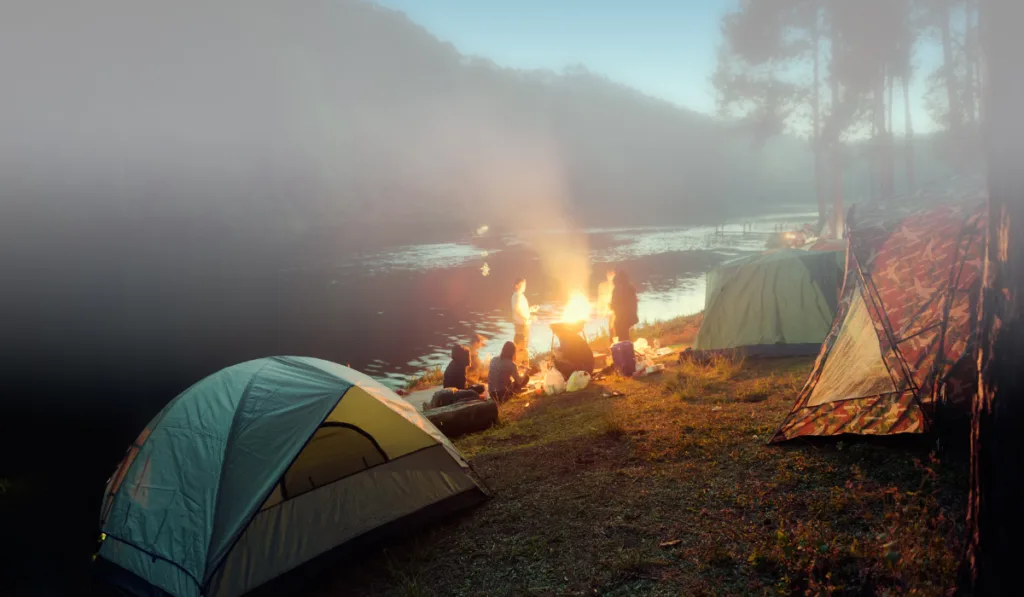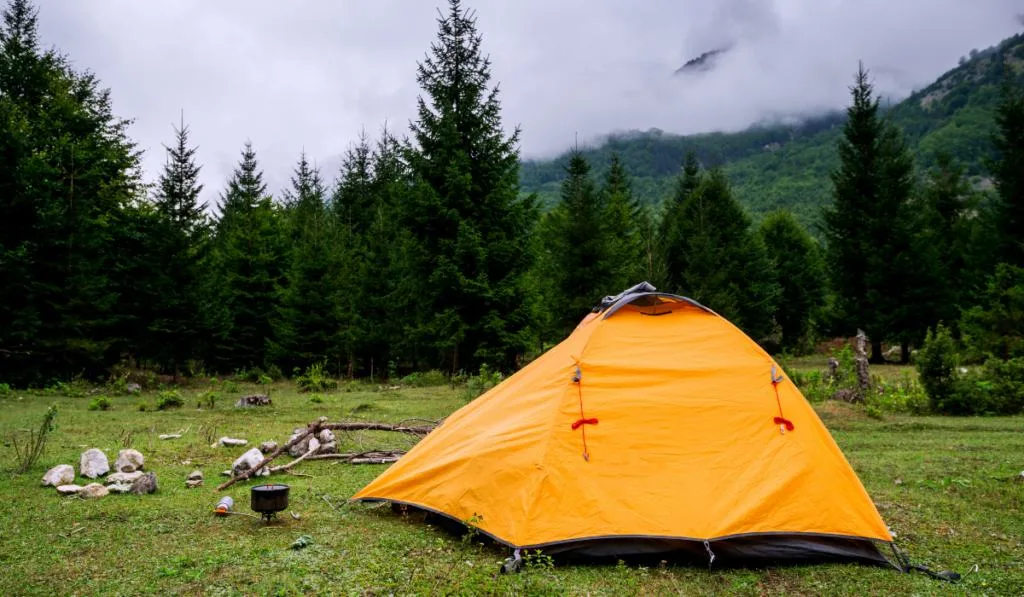If you are looking for a tent, you might be wondering about the difference between a backpacking tent and a camping tent and which among these two is best suited for you.
Backpacking tent versus camping tent—what’s the difference?
In a nutshell, backpacking tents are lighter than camping tents. They should be easy to carry, especially if you’re going to hike long distances.
On the other hand, camping tents are heavier than the former, but they are sturdier and have options for larger sizes. Both tents also use different materials and different pole types.
There are more differences between the two we’ll discuss in this article. But before we go through the differences between a backpacking tent and a camping tent, let’s quickly go over a brief background between backpacking and camping.

Table of Contents
What is Backpacking?
Backpacking is an exciting outdoor activity that involves taking a journey on foot to explore new trails and lands to create new experiences. It is called backpacking because you are required to carry all the things you need in a backpack.
Since backpacking requires you to walk for miles on a trail before finding a good spot to pitch a tent, you must pack wisely.
This means that you must pack all your essentials, including clothes, food, camping gear, and an emergency kit, but you need to keep it lightweight so that you don’t drain your energy from carrying too much weight.
What is Camping?
Camping is also an outdoor activity, but unlike backpacking, you don’t have to walk to reach your destination. Instead, there are designated camping sites, usually in a national park, where you can park your car, bring your camping gear, and set up your tent.
Once you are settled, you can leave your things and explore the entirety of the campsite. It usually has the utilities that you need, including a shower with a sink and a toilet.
Because camping does not involve walking for miles, you won’t have to worry about bringing a heavy tent.
Now, let’s go over the differences between the two tents.

Backpacking Tent vs. Camping Tent: What’s the Difference?
There are certain characteristics of a backpacking tent that will help you identify if this is the right tent for you.
Capacity
Backpacking tents usually range from one-person to four-person models. However, it is important to consider that a four-person tent might be too cramped for four adults sleeping in it at once.
Therefore, it is important to read the measurements carefully as each brand differs in size.
Ideally, if you’re bigger than an average-sized person, you might consider purchasing a two-person backpacking tent so that you’ll be more comfortable.
On the other hand, camping tents widely vary in size.
Since camping is an activity for family and friends, it is evident that you will need a large tent to accommodate everyone. Some can even fit a dozen or more people at a time.
However, if you’re camping alone, we recommend that you bring a backpacking tent instead. This is because a single-person camping tent usually tends to be heavier than a two-person backpacking tent, making the latter easier to carry, especially if you’re alone.

Material and Durability
The durability of the tent depends on the material used. There are several types of fabrics used in a backpacking tent, including polyester, nylon, and Dyneema, among others.
Backpacking tents made from Dyneema are usually expensive because this material weighs less than others but is stronger and more durable.
Meanwhile, nylon is cheaper, but it is heavier and not as durable as Dyneema. Nonetheless, nylon still makes a decent choice for an average backpacker.
Camping tents come in various fabrics too, including polyester, nylon, canvas, polycotton, and polyurethane. Each has its benefits and will make a great option depending on the user.
Let’s take a look at some of the most popular fabrics used in camping tents:
1. Polyester
Polyester is made of plastic, which makes it water-resistant.
The thickness varies depending on how it is made. While polyester will do the job of keeping the rain out, expect some water to still seep in.
Moreover, while polyester is waterproof, it is not as breathable as other fabrics made of natural materials.
2. Nylon
Like polyester, nylon is also made of plastic, enabling it to be water-resistant but not necessarily waterproof and breathable.
In general, nylon is lighter yet more durable than polyester because it is stretchier and more resistant to tearing.

3. Canvas
Canvas consists of natural materials, specifically linen or cotton. Unlike polyester and nylon, canvas is not waterproof, which means that it will absorb and take in water when it rains.
You can make canvas waterproof by using a waterproof treatment, although it will take a few days to do that, and there’s no assurance that it will be 100-percent effective.
The good thing about canvas is that, unlike tents made of synthetic materials, it is more breathable, thus increasing ventilation in the tent.
4. Polycotton
You can tell from the name itself that polycotton is made by combining polyester and natural cotton. Some manufacturers use equal parts of both materials, while others use more of one material than the other.
Polycotton supplies the strengths of both synthetic and natural materials.
It is sturdier than canvas and nylon but has a limited range of thicknesses.
Polycotton is also lighter than natural fabrics but not as light as synthetic ones. Regardless, it is still relatively easy to carry. However, polycotton is not as waterproof as polyester and not as breathable as pure canvas.
Pole Materials

The material for tent poles also differs depending on the tent’s type, purpose, and features.
For backpacking tents, the most common types of pole materials are aluminum and carbon fiber.
1. Aluminum
Aluminum is commonly used in several types of tents, including backpacking and camping tents, because of its strength, flexibility, and weight.
Unlike other pole materials, aluminum is much lighter, and it doesn’t break easily; instead, it bends.
The drawback of aluminum is that it can corrode, so wash your aluminum poles with fresh water after using them near the sea. Fortunately, some manufacturers protect aluminum from corrosion by using certain preventive measures, such as anodizing.
Aluminum poles are also more expensive compared to other poles.
2. Carbon fiber
Carbon fiber is lighter and stronger, but it is more expensive than aluminum. Carbon fiber is usually used to make very lightweight tents; thus, you won’t usually see them in camping tents.
Instead, carbon fiber poles suit professional backpackers who go on long adventures.
While carbon fiber poles are known for being ultralightweight, carbon fiber is not excellent when it comes to flexibility.
On the other hand, camping tents commonly use poles made of fiberglass and steel.

1. Fiberglass
Fiberglass is a decent pole material commonly used in various affordable camping tents.
These poles are cheap but are heavier and can crack when under too much pressure, as well as when used in very chilly weather. Therefore, fiberglass is best suited when camping in summer.
Some fiberglass poles contain different pole materials, such as steel and aluminum. Unlike aluminum, fiberglass poles do not corrode.
However, because they are not as flexible as aluminum, fiberglass poles need careful handling.
2. Steel
Steel is a heavy material, so it isn’t used in backpacking tents. Instead, you’ll see steel poles in cabin-style and tunnel tents. Sometimes, they are used in dome-style tents too.
Steel is outstandingly strong at an affordable cost. However, steel poles are heavy and prone to corrosion.
Weight
Weight plays a massive role in distinguishing a backpacking tent from a camping tent.
A backpacking tent should be lightweight as backpacking involves walking on a trail for miles.
Meanwhile, camping tents are usually heavier since they prioritize the size and capacity more than the weight. A camping tent may be heavy, but it should be big enough to hold a family or a group of friends.
Headroom

Most tent manufacturers include a diagram of the tent’s dimensions after it has been set up. From this, you’ll get an idea of whether the inside height of the tent is comfortable enough for you.
For backpacking tents, don’t expect to be able to stand inside. However, they should have enough space for you to comfortably sit up straight.
Meanwhile, camping tents are usually designed for the whole family to move around freely. This means that they are taller than backpacking tents, thus allowing campers to stand up inside the tent.
Seasons
For the most part, both the backpacking and camping tent are similar when it comes to seasons.
The only difference is that backpacking tents come in single-season, three-season, and four-season designs while camping tents only come in three-season and four-season designs.
As its name suggests, a single-season tent is designed for a single season—summer.
Meanwhile, a three-season tent can be used in the spring, summer, and fall. They can be used in winter too, so long as there’s no heavy snow or ice.
A four-season tent can withstand the four seasons, but they are mostly designed for winter camping, wherein you expect heavy snow and ice.
Features
While backpacking tents are usually designed for a backpacker to sleep comfortably, camping tents come with additional features.
For example, since camping tents are larger than backpacking tents, camping tents may have multiple windows, room dividers, and more to enable proper ventilation.
However, more features also mean more cost.

What Is the Cost Difference Between Backpacking and Camping Tents?
In general, the lighter the tent is, the more expensive it will be. That said, backpacking tents tend to cost more than camping tents.
If you look them up online, you will see that a decent two-person backpacking tent will cost $300 and above compared to a two-person camping tent that only costs $300 and below.
When Should You Use a Camping Tent?
From the differences that we talked about, a camping tent is ideal when you’re not going on a trail or hike to reach your destination.
If you’re backpacking as a group, it is also possible to bring a camping tent that will fit everyone so that everyone doesn’t need to bring their tent.
However, the one who would carry the tent would transfer his belongings for other campers to carry because the tent is heavy.
When Should You Use a Backpacking Tent?
A backpacking tent is ideal if you’re indeed going on a backpacking trip. The lightweight tent allows you to be more agile, especially if you’re going on a long expedition.
You may also use a backpacking tent if you’re going on a camping trip alone. A two-person backpacking tent is still more lightweight than a one-person camping tent.
Conclusion
After reading this article, hopefully, you are now able to decide which type of tent best fits your next backpacking or camping trip.
Keep in mind that the most important thing is to just enjoy the moment, and you can’t do so if you bring a tent that isn’t fit for the season, is too heavy to carry, or does not fit enough people. So, choose wisely and stay safe on your next trip!
Resources:
- https://ridgetrekker.com/backpacking-and-camping-tents/
- https://purehiker.com/backpacking-vs-camping-tents/
- https://seekoutside.com/blog/tent-fabrics-a-comparison-of-fabric-types/
- https://wildernessredefined.com/best-tent-fabric-and-material/
- https://familycamptents.com/what-is-the-best-material-for-tent-poles/#aluminum
- https://www.outdoorgearlab.com/topics/camping-and-hiking/best-camping-tent/buying-advice
